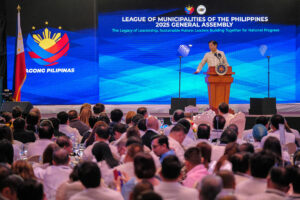OVER 1,200 local government units (LGUs) have now initiated automation efforts to enhance efficiency and transparency in public service delivery, President Ferdinand R. Marcos, Jr. said on Wednesday.
The administration is focusing on streamlining and digitalizing bureaucracy to make government services more efficient, through initiatives like the Electronic Business One-Stop Shop (eBOSS), Mr. Marcos said during the League of Municipalities of the Philippines General Assembly in Manila City.
“As of last year, 113 out of 1,634 LGUs have fully complied with the eBOSS requirement. Meanwhile, over 1,200 LGUs have now initiated automation efforts to enhance their transactions,” he noted.
To further accelerate digitalization, the government has developed the eLGU platform, a ready-to-use eBOSS system that has been adopted by 741 LGUs as of 2024.
“Critical government frontline services are becoming more transparent and accessible,” Mr. Marcos said.
The administration is also rolling out the Modernized Philippine Government Electronic Procurement System to improve efficiency and transparency in public procurement.
With features such as a Virtual Store, e-Wallet, e-Payment, and e-Marketplace, the system aims to simplify processes, enhance accountability, and safeguard public funds.
The president underscored the need for the country to keep pace with global technological advancements, warning that nations failing to embrace innovation risk being left behind.
“Understanding and maximizing technology is essential to improving public services,” he said in Filipino.
Meanwhile, the government is also ramping up environmental initiatives, with 22,200 barangays participating in clean-up activities last year under the Kalinga at Inisyatiba Para sa Malinis na Bayan program.
Mr. Marcos highlighted the urgency of addressing climate change’s impact at the municipal level, urging LGUs to adopt proactive measures to protect communities.
The League of Municipalities in the Philippines convened local chief executives, with the aim to empower them with advocacy tools, strategic frameworks and collaborative opportunities to drive improvements in their communities. — Chloe Mari A. Hufana






